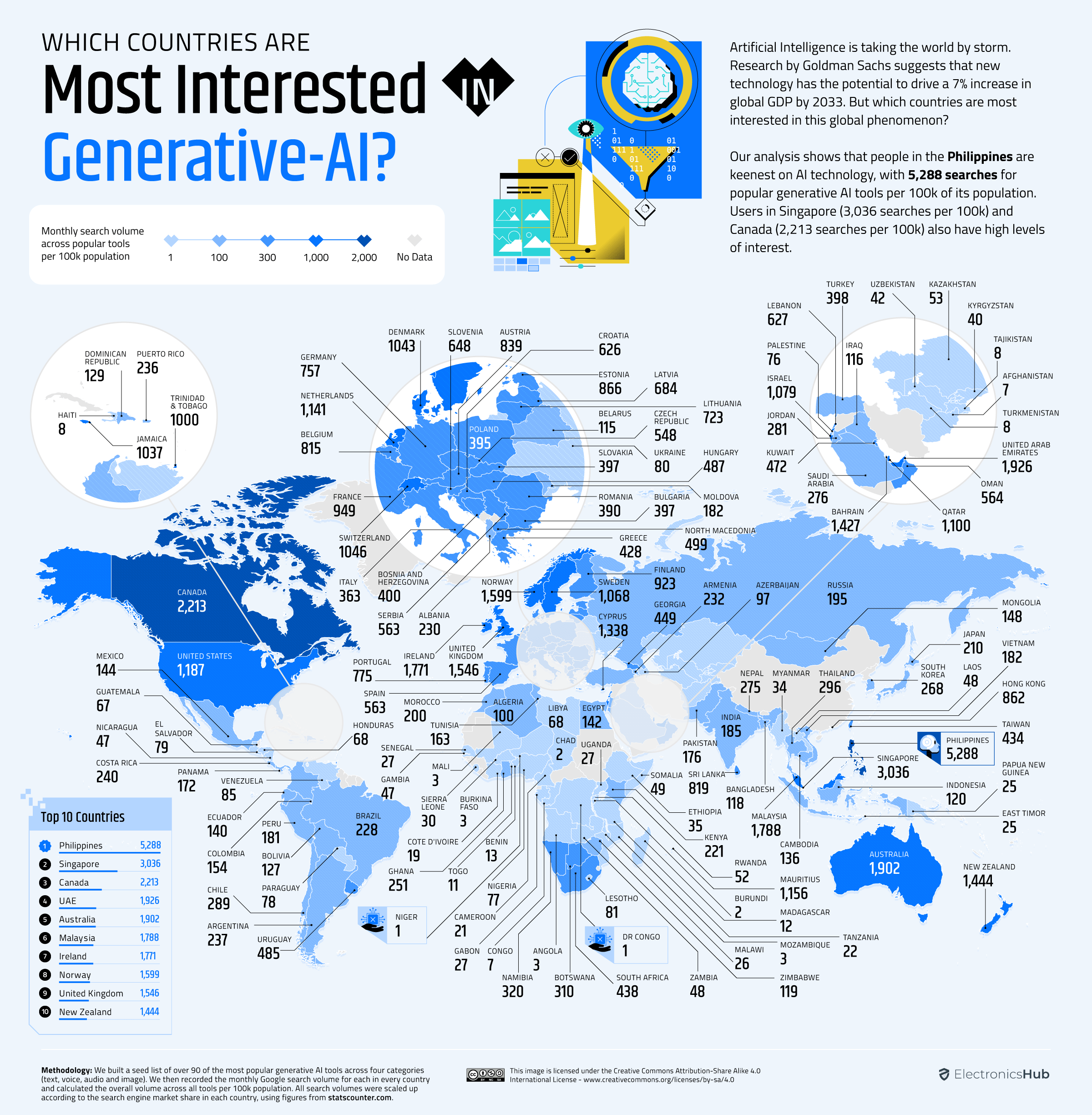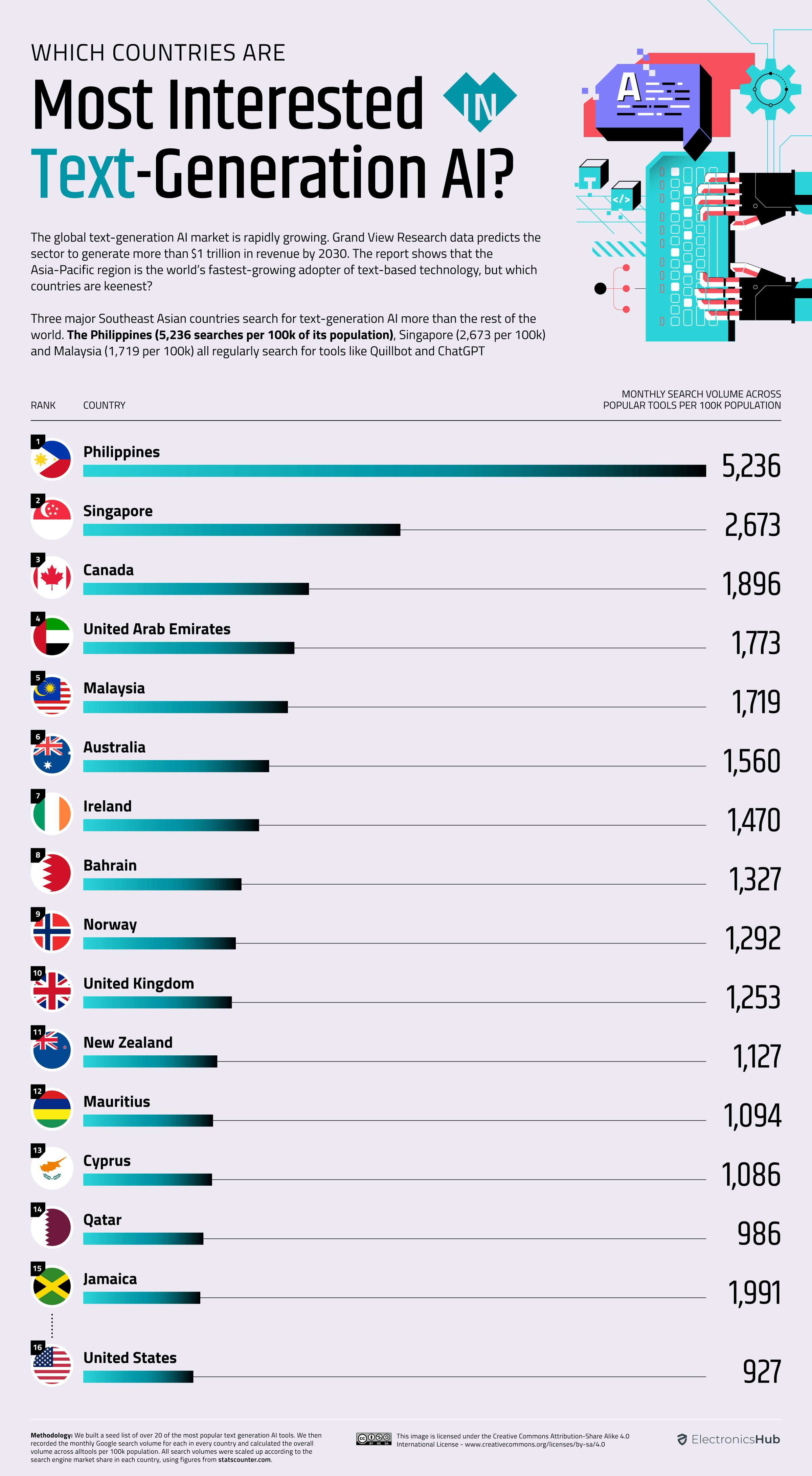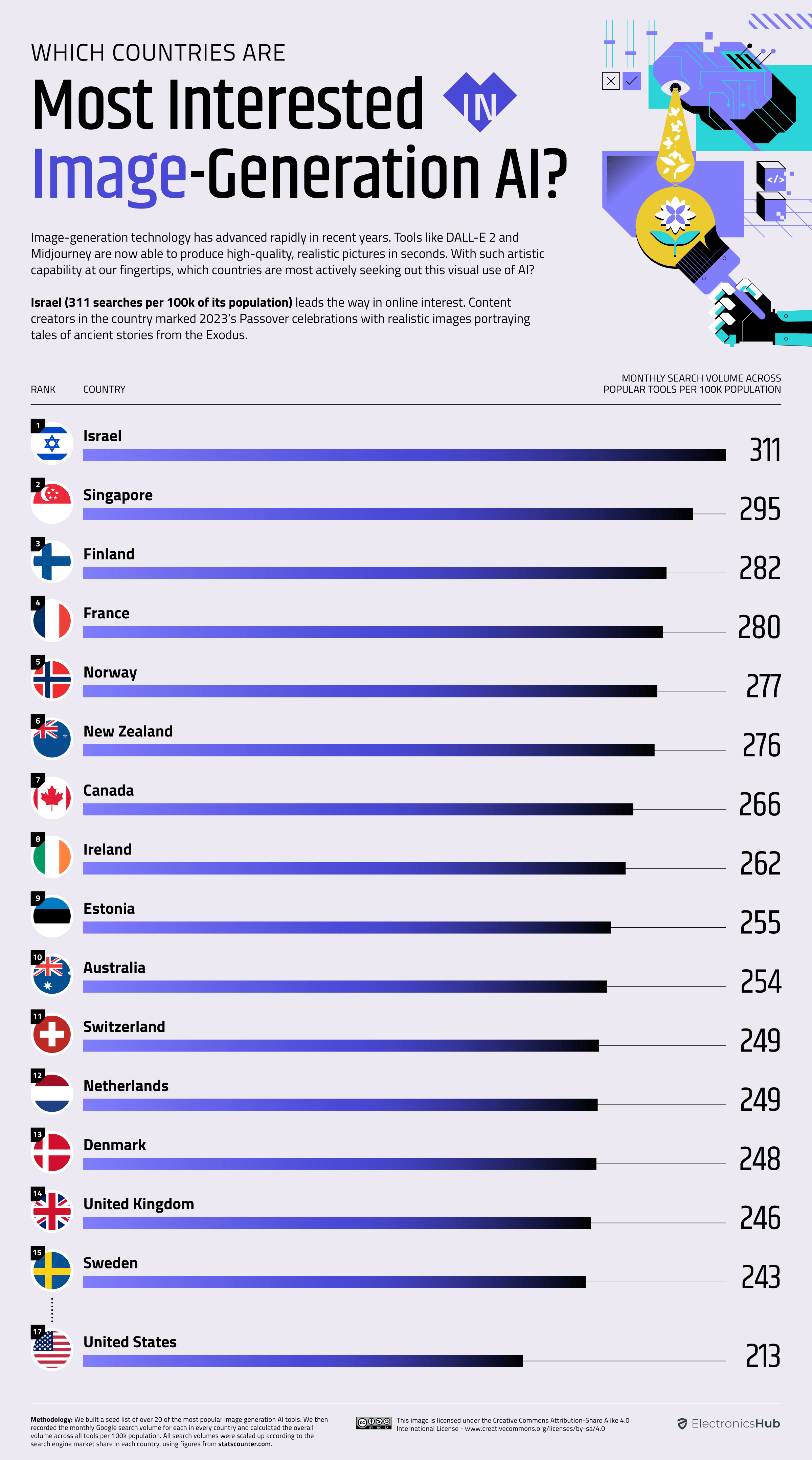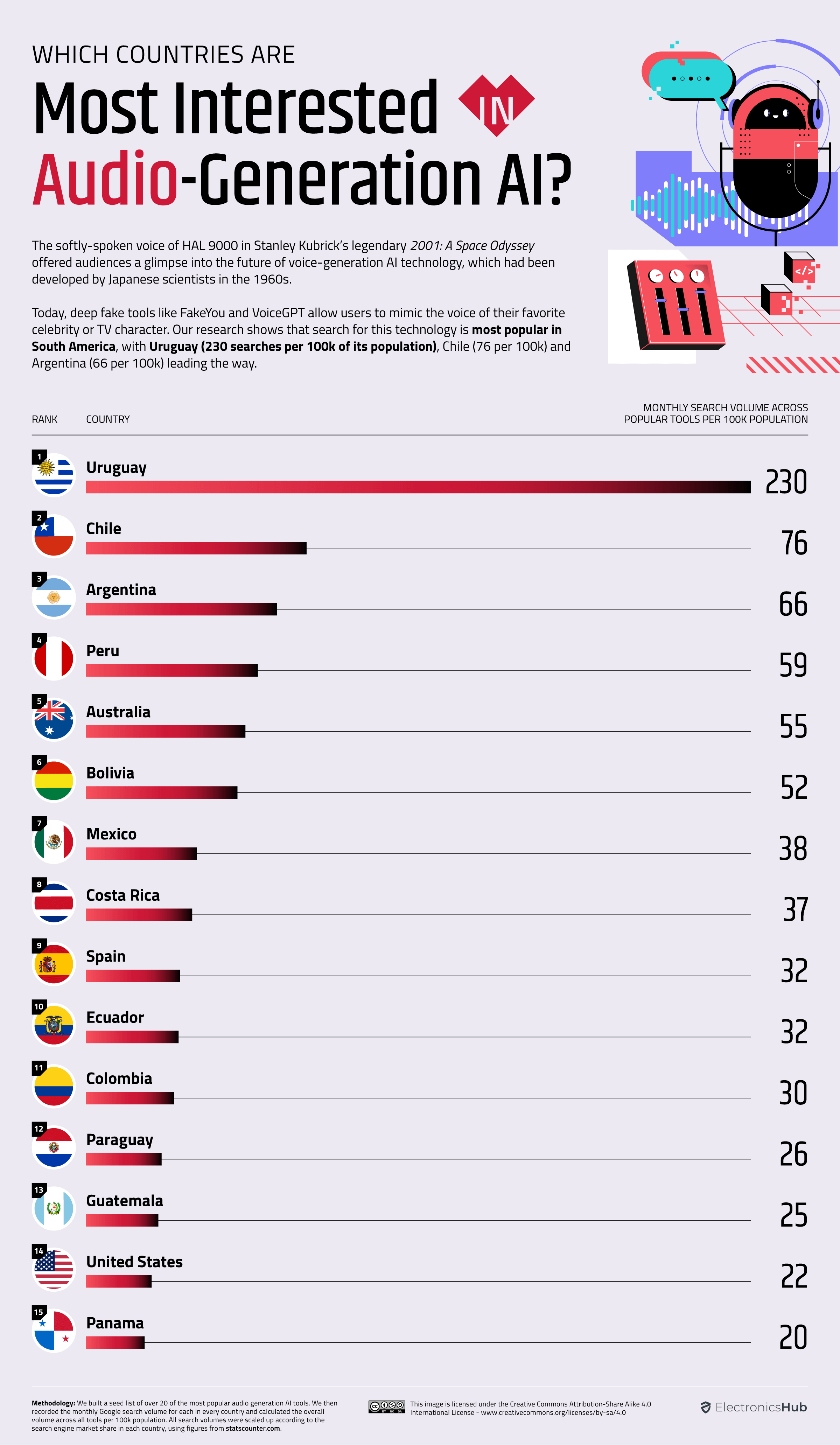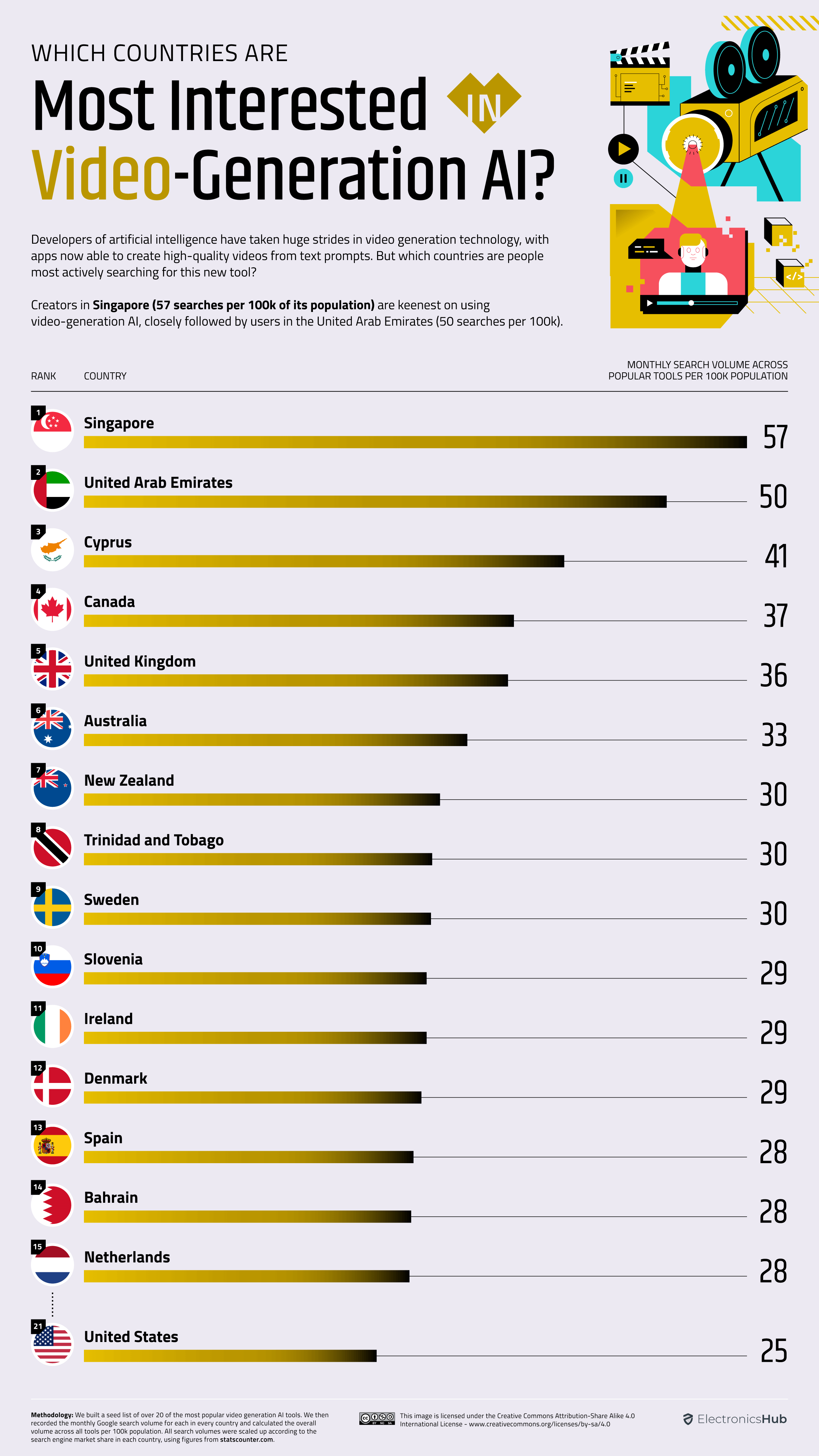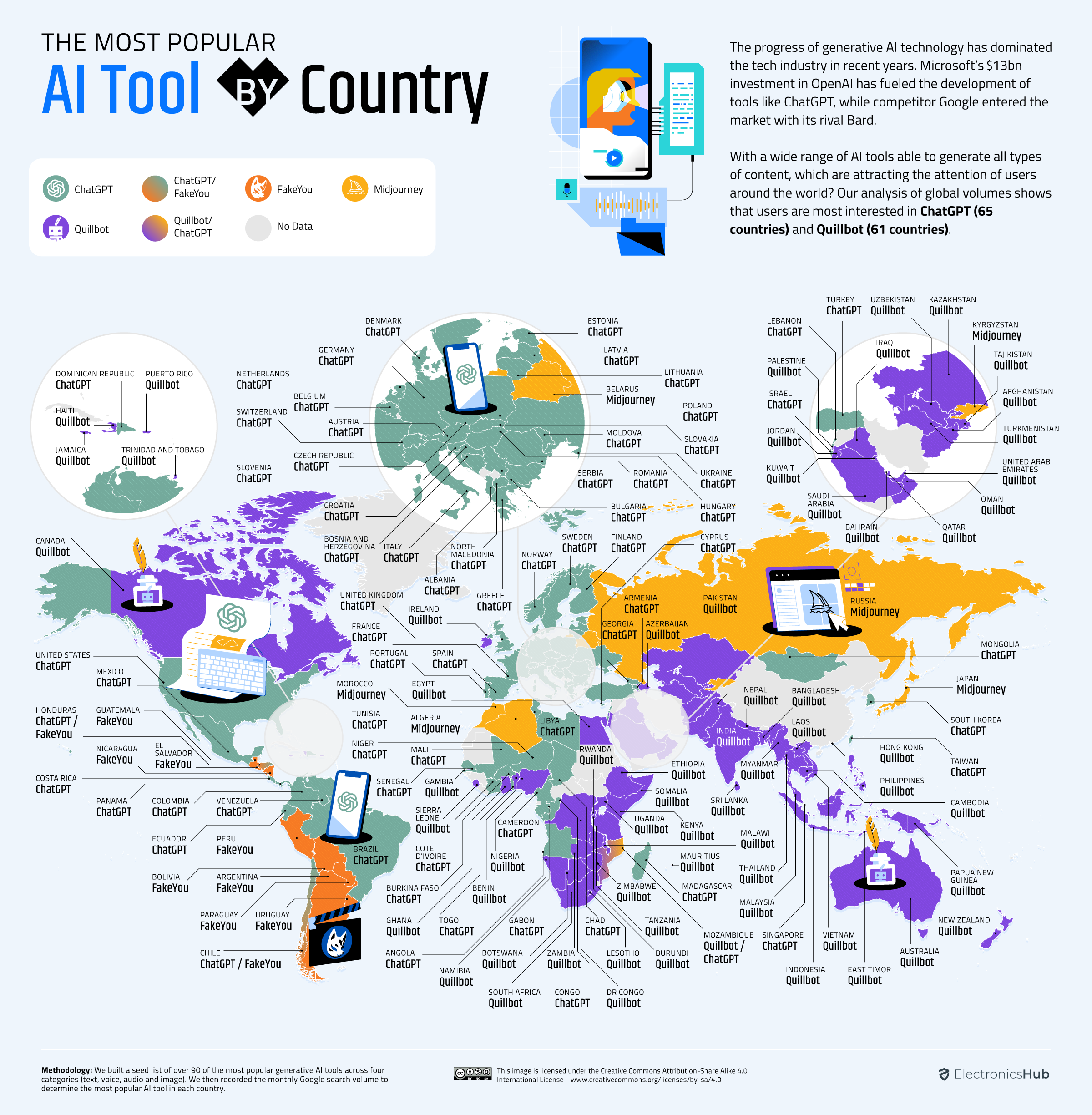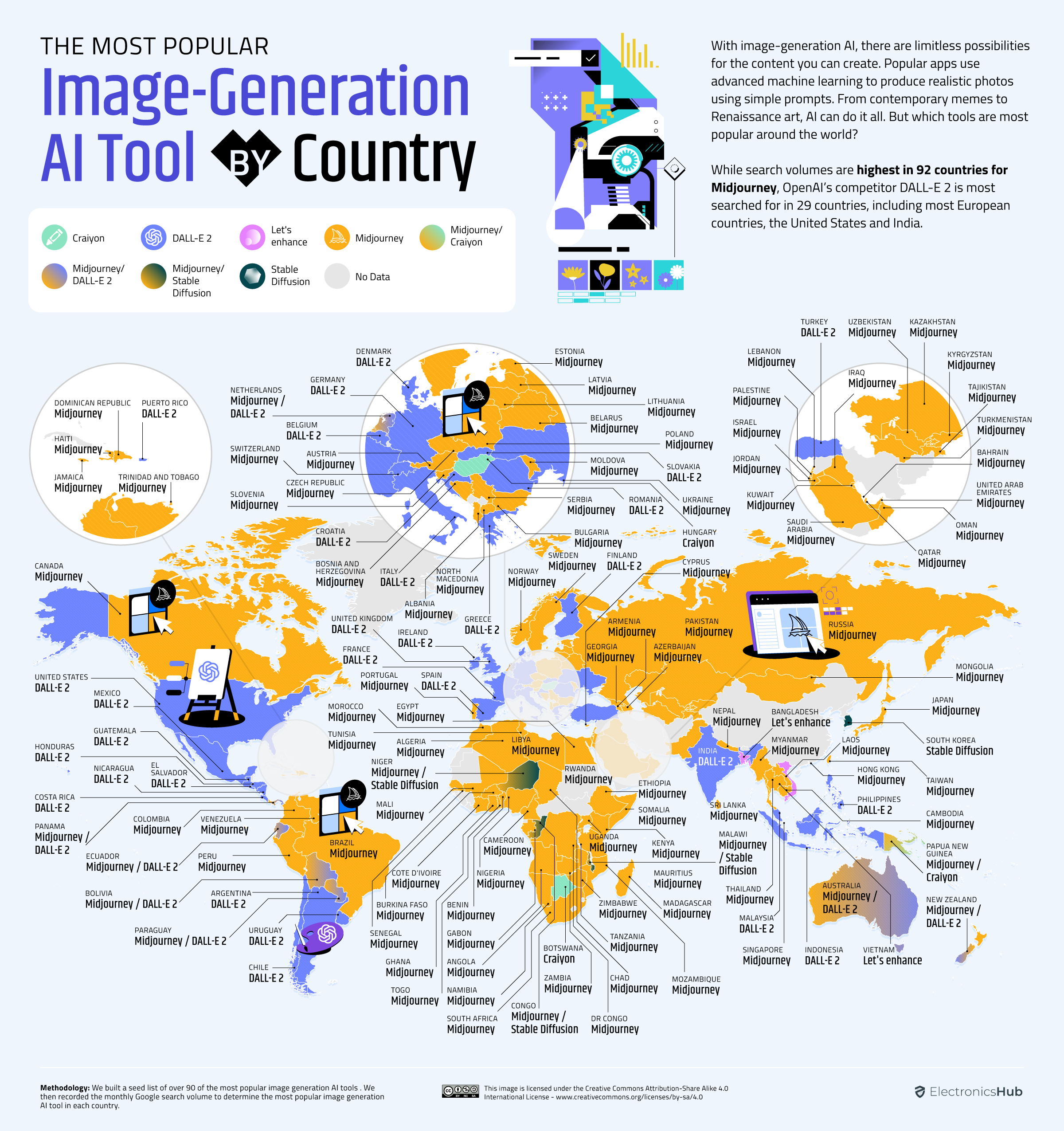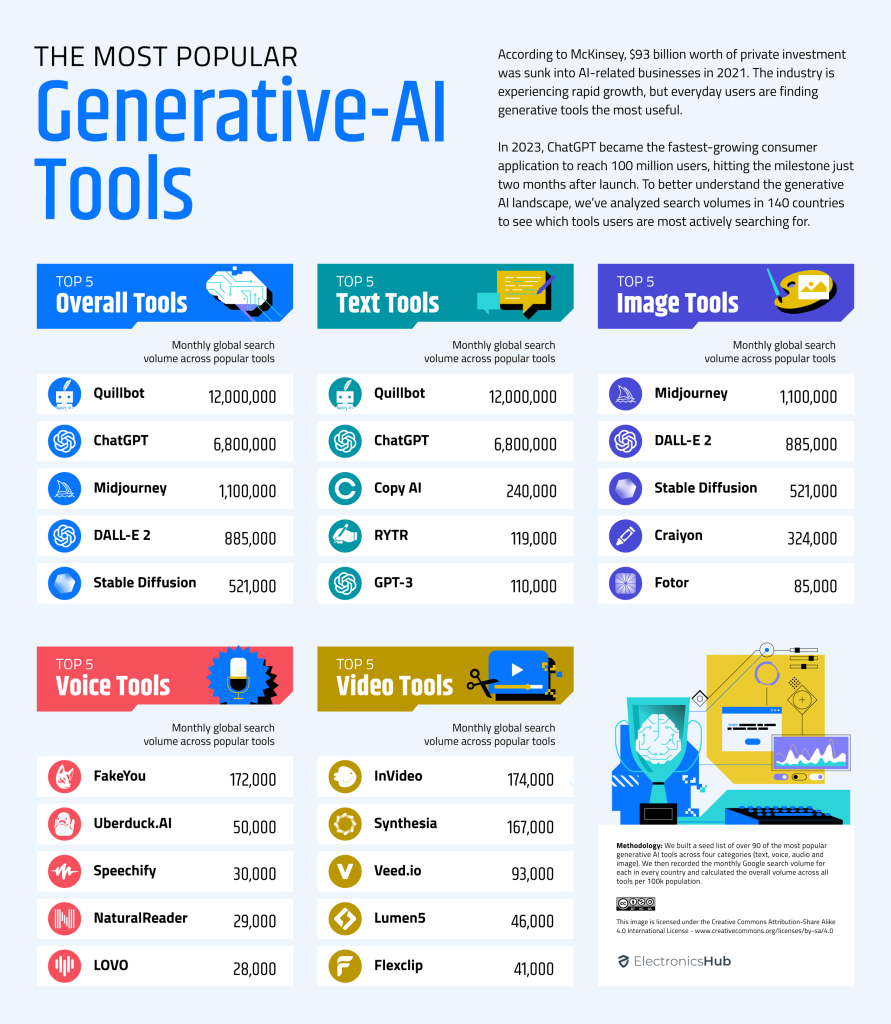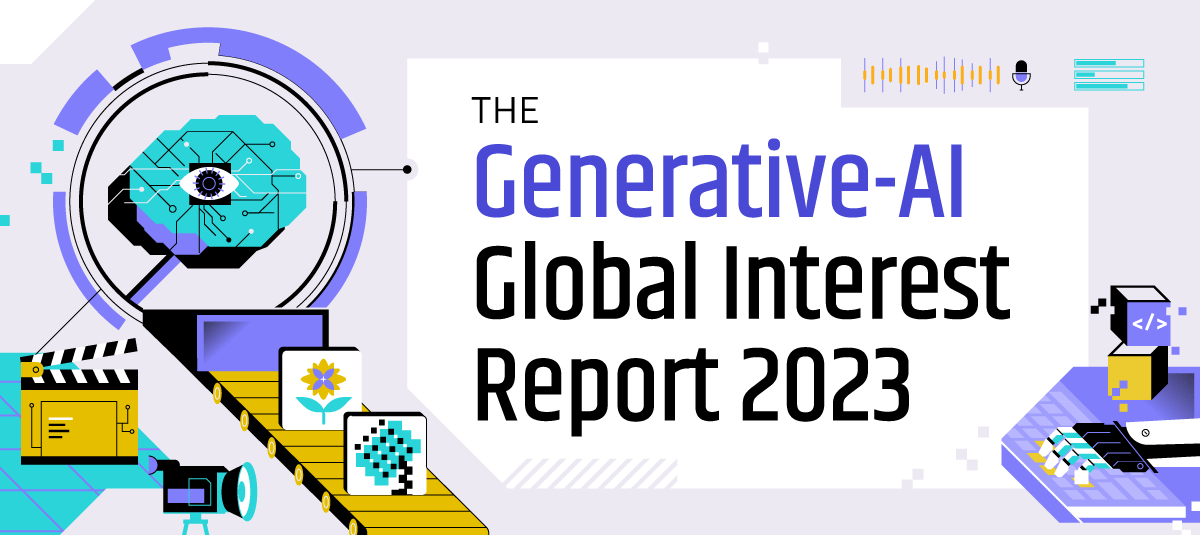
Might there be a poet in the machine, after all?
Generative-AI tools are rapidly transforming multiple sectors, from marketing and journalism to education and the arts.
These tools use algorithms to derive new text, audio or images from massive banks of training material. While the likes of ChatGPT and Midjourney could be used to achieve artistic effects beyond human capability or imagination, for now they are most used to produce human-like content more effortlessly than a human might. And the results are uncanny — provoking many to question if (or when) we might consider AI to have become truly intelligent or even sentient.
Still, whether they’re using it as a tool, a cheat or an experimental new art form, those who are gonna use generative AI are gonna use it. Curious about which cultures were most eager to adopt these poetic algorithms, Electronics Hub analyzed Google search data to identify the countries searching for text, voice, audio and image bots the most.
Outline
Toggle- What We Did
- Asian Countries and Canada Among Biggest Fans of Text Generation
- Generative-Image AI Remains Little Sibling to Text Tools
- Audio AI Powers Music Revolution — and Fan-Made Soundalikes
- Video AI Is Coming One Department at a Time
- Generative-AI Text Tools Dominate Global Search Patterns
- Midjourney is the Most-Searched Image AI in 92 Countries
- The Most Popular Generative AI Tools in Every Category
- Mad, Bad and Dangerous to Prompt
- Culture and Technology the Debate Surrounding Generative AI
What We Did
Electronics Hub built a list of over 90 of the most popular generative-AI tools in four categories (text, voice, audio and image). We recorded the monthly Google search volume for these tools in every country by category and overall to find how many searches each country makes per 100,000 people. The most popular tools are those with the highest monthly search volume.
Key Findings
- The Philippines has the highest monthly search volume for AI tools overall: 5,288 per 100,000 population, mostly for text AI.
- ChatGPT is the most-searched generative-AI tool in the most countries (65), including the U.S.
- Quillbot is the most-searched tool in the second-most countries (61) but has the highest search volume overall (12 m global searches per month).
- Midjourney is the most-searched image generation tool in 92 countries.
Click here to see the image in full size
Asian Countries and Canada Among Biggest Fans of Text Generation
Text generation went supernova in 2022, with the launch of GPT3.5 and 4 and headline events such as Google engineer Blake Lemoine announcing his belief that the company’s chatbot had become sentient. This type of tool has the most broadly applicable use value so far. It is searched for at a far higher volume than image generation tools as job applicants and respected websites use it to produce neatly written, if factually flawed, sentences.
Click here to see the image in full size
It remains to see how sustainable mass use of AI text tools might be, however, given that AI models will soon be training themselves on great swathes of AI-generated internet content: “Just as we’ve strewn the oceans with plastic trash and filled the atmosphere with carbon dioxide,” warns Ross Anderson, Professor of Security Engineering at the University of Cambridge, “so we’re about to fill the Internet with blah.”
Generative-Image AI Remains Little Sibling to Text Tools
Text-to-Image generation breakthroughs were the AI story of 2022. The emergence of Dall-E 2 sparked an AI arms race that forced rival tools such as Midjourney and Stable Diffusion out into the open and amplified the impact of advances in text generation.
Click here to see the image in full size
While the burgeoning artistic technique of “promptism” has flourished in the wake of these developments, the user group for text-to-image is far narrower than that for text generation because language is something that we all use daily. So, for example, Singapore has the second-highest number of searches for both text and image AI — but the Singaporean figure for text generation is nearly ten times higher compared to the figure for text-to-image.
Audio AI Powers Music Revolution — and Fan-Made Soundalikes
“It’s part of an artist’s odyssey: discovering your own voice and struggling to find the combination of qualities that makes you unique,” says musician Tom Waits. “Now I’ve got these unscrupulous doppelgängers out there — my evil twin who is undermining every move I make.” As it happens, Waits said this about the use of human impersonators in 2006, long before it was feasible to copy his voice with AI.
Click here to see the image in full size
However, as recent fake Drakes and Weeknds have demonstrated, audio fakes are likely to soar now that they can be made with an app. Latin American countries lead the way with searches for AI audio tech. And perhaps new sample-friendly AI tools from Facebook and Google will power the next wave of the Latin music boom.
Video AI Is Coming One Department at a Time
Video is something of a holy grail for AI — and it isn’t there yet. Making convincing images that move 20+ times per second is expensive and difficult, with or without AI. The best use cases for synthetic video so far include auto-generating just part of a moving image (for example, the faces in a deep fake video) or creating simple, avatar-led videos for corporate purposes. This is the selling point of Synthesia, the second most-searched video AI tool in the world.
Click here to see the image in full size
Video AI is the one category where Anglophone countries are among the biggest searchers, with Singapore (where the official business language is English) in first place. Meanwhile, Vimeo is leaning heavily into AI, announcing a suite of AI-powered script generation and editing tools, even if text-to-video remains on the horizon.
Generative-AI Text Tools Dominate Global Search Patterns
Ada Lovelace foresaw the ability of computer algorithms to generate images and sound nearly 200 years ago: “Supposing, for instance, that the fundamental relations of pitched sounds in the science of harmony and of musical composition were susceptible of such expression and adaptations, the engine might compose elaborate and scientific pieces of music of any degree of complexity or extent.” However, for now, the big breakthrough and the key use value of generative AI is its ability to understand and utilize natural language, an essential element in the top image and sound tools as well as in text generation.
Click here to see the image in full size
Text tools are the most popular AI solution in 129 countries around the world because they are effective and broadly applicable. In addition to the headline-grabbing ChatGPT, Quillbot is a big hitter — particularly in non-English speaking countries — for its simple interface, which promises to quickly rewrite pasted text neatly and fluently in over 20 languages.
Midjourney is the Most-Searched Image AI in 92 Countries
While headline-grabbing tools such as Dall-E 2 and Midjourney are little more than novelty toys for most people, their uncanny ability to conjure (mostly) convincing images in a range of styles in the time it takes to imagine them has already had a massive impact on designers and illustrators. Some have searched for AI solutions to creative (or administrative) problems, some have integrated it into experimental workflows and others — those in the most precarious positions — are losing work or facing unrealistic expectations about their “productivity” in the age of AI.
Click here to see the image in full size
We have found that the highest volume of image generation searches occurs in the world’s wealthiest countries. This resonates with the IMF’s concern that “that new technology risks widening the gap between rich and poor countries by shifting more investment to advanced economies where automation is already established.”
Meanwhile, the latest Nikon camera ad campaign sets out to convince photographers — or those who hire them? — that nothing an AI image can show can capture the wonder of “natural intelligence.”
The Most Popular Generative AI Tools in Every Category
“The Analytical Engine has no pretensions whatever to originate anything,” wrote Lovelace in 1843. “It can do whatever we know how to order it to perform. It can follow analysis, but it has no power of anticipating any analytical revelations or truths. Its province is to assist us in making available what we are already acquainted with.” Lovelace inadvertently highlights some of the best and worst of generative AI today: it is a recursive machine, trained only on what we give it, but the results continue to startle us with their combination of the familiar and the novel or previously impossible.
Click here to see the image in full size
For now, humankind’s primary use of AI seems to be completing everyday writing tasks: the most popular AI tools, Quillbot and ChatGPT, are respectively ten and six times more popular than the most-searched image tool (Midjourney). And the average search volume for the top five text tools is 6.6 times that of the top five image tools. History is being written — or rewritten — before our eyes.
Mad, Bad and Dangerous to Prompt
From a 21st-century perspective, at the dawn of the age of the ubiquitous generative-AI tool, Ada Lovelace’s metaphor of the computer as Jacquard-loom is double-edged. Just as 19th-century advances in loom technology provoked textile workers to smash the new machines that threatened their jobs, today’s designers, writers and musicians fear they will be undercut by cheaper, faster automation machines.
Job losses and reduced wages weren’t the only fallout from those developments. Mass production led to skill atrophy, alienation from the means of production, profound class divisions and environmental ruin. “The difference this time,” according to The Guardian, “is that the jobs most at risk will be white-collar, middle-class jobs, while many of the jobs created might be of the low-paid, dead-end variety.”
You can check our full data on which of these generative-AI tools are getting the most interest in the interactive table below.
Let’s conclude with one of Ada Lovelace’s more modest statements – one that hints at the sort of humility we could use from the companies selling us AI solutions today: “I never am really satisfied that I understand anything; because, understand it well as I may, my comprehension can only be an infinitesimal fraction of all I want to understand about the many connections and relations which occur to me…”
On the other hand, perhaps today Lovelace would have no qualms with using a bot to help her with that.
Culture and Technology the Debate Surrounding Generative AI
To some, the question of whether the machine “thinks” or produces real art can be considered moot if it gets them where they want to go or loses them their job. But others might look back to Ada Lovelace, the mathematician credited with writing the first-ever computer algorithm back in 1843.
Lovelace’s mother, Annabella Byron, had set her daughter to study the sciences rather than the art, hoping to suppress the “dangerous and potentially destructive” side she inherited from her estranged father, the poet Lord Byron — to whom Annabella wrote that young Ada was “Not devoid of imagination, but is chiefly exercised in connection with her mechanical ingenuity.”
But Lovelace’s poetic side walked hand in hand with that “mechanical ingenuity.” She is best remembered for using her STEM and literary powers to explain Charles Babbage’s proto-computer with a depth and foresight beyond that of Babbage himself: “We may say most aptly that the Analytical Engine weaves algebraical patterns just as the Jacquard-loom weaves flowers and leaves,” she wrote, annotating her translation of an 8,000-word paper on the device with 12,000 words of her own — illustrating the power of the poetic in how we conceive industrial advances.
Humans can find beauty in the patterns created by factory machinery, just as we find beauty in mathematical patterns in nature, such as fractals and the Fibonacci spiral. This is a topic that Alan Turing — the ‘father of modern computer science’ who revived and debated Lovelace’s work a century later — was working on at the end of his life.
But for all the visual and textual poetry that’s emerging from the generative-AI boom, a key issue is that AI tools do not use mathematically pure patterns nor put neutral tools in the hands of the masses. The tools feed, non-consensually, on works produced by other humans — replicating both the ideas and the prejudices in that which has been published to date. And they are calibrated and remotely harnessed by a handful of corporations whose view of poetry is somewhat more cynical than Lovelace’s and is expressed in terms of disruption:
“No matter what a specific technology does,” writes Rob Horning, “— convert the world’s energy into gambling tokens, encourage people to live inside a helmet, replace living cognition with a statistical analysis of past language use, etc., etc. — all of them are treated mainly as instances of the “creative destruction” necessary for perpetuating capitalism.”
As we navigate the AI boom, it is crucial to address the ethical concerns surrounding its reliance on existing human works and its controlled deployment by a few corporations, highlighting the clash between the view of culture as disruptive and more important the possibility of blending creativity and innovation.
METHODOLOGY & SOURCES
To find out which locations are most interested in AI around the world, we created a list of generative AI tools sorted into four categories: text, image, voice and video, using various sources including Search Engine Journal and Forbes for this list.
Then we determined the top 10 tools in each category based on their global monthly search volumes using Ahrefs. We then recorded the monthly Google search volume for each in every country and calculated the overall volume across all tools per 100k population to determine interest. The most popular tools overall and by category were those with the highest monthly search volume.
All search volumes were scaled up according to the search engine market share in each country, using figures from statscounter website.
The data is correct as of July 2023.

